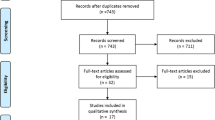Abstract
Purpose
The purpose of this study was to determine the differences in polysomnographic variables between obese adolescents with polycystic ovarian syndrome (PCOS) and healthy, normal-weight and obese controls, as the prevalence of obstructive sleep apnea syndrome (OSAS) is increased in adults with PCOS.
Methods
Twenty-two obese adolescents with PCOS (mean age 15.2 ± 1.3 years, mean BMI 31.7 ± 6.2 kg/m2), 18 healthy, normal-weight adolescents (mean age 15.0 ± 0.9 years, mean BMI 20.6 ± 2.3 kg/m2), and 11 healthy, obese adolescents (mean age 15.0 ± 1.0 years, mean BMI 34.8 ± 8.7 kg/m2) underwent polysomnography to compare mean transcutaneous arterial oxygen saturation (Sat O2), apnea index (AI), hypopnea index (HI), apnea–hypopnea index (AHI), the absolute number of obstructive apneas (NOA), percentage sleep stages 3 and 4 of non-REM sleep (stages 3 and 4), percentage of REM sleep (%REM), sleep-onset latency, and sleep efficiency.
Results
We found no differences between the three groups concerning Sat O2, AI, HI, AHI, NOA, and stages 3 and 4. The girls with PCOS differed from normal-weight and obese controls regarding sleep-onset latency and sleep efficiency and from the normal-weight controls regarding %REM.
Conclusions
OSAS does not seem to be more prevalent in adolescents with PCOS. Concerning the respiratory variables, adolescents with PCOS do not seem to differ from healthy controls; however, there seem to be differences concerning sleep architecture.
Similar content being viewed by others
References
Stein IF, Leventhal ML (1935) Amenorrhea associated with bilateral polycystic ovaries. Am J Obstet Gynecol 29:181–191
Knochenhauer ES, Key TJ, Kahsar-Miller M, Waggoner W, Boots LR, Azziz R (1998) Prevalence of the polycystic ovary syndrome in unselected black and white women of the southeastern United States: a prospective study. J Clin Endocrinol Metab 83:3078–3082
Zawadski JK, Dunaif A (1992) Diagnostic criteria for polycystic ovary syndrome: towards a rational approach. In: Dunaif A, Givens JR, Haseltine FP, Merriam GR (eds) Polycystic ovary syndrome. Blackwell, Boston, pp 377–384
Sam S, Dunaif A (2003) Polycystic ovary syndrome: syndrome XX? Trends Endocrinol Metab 14:365–370
Ehrmann DA (2005) Polycystic ovary syndrome. N Engl J Med 352:1223–1236
Fogel RB, Malhotra A, Pillar G, Pittman SD, Dunaif A, White DP (2001) Increased prevalence of obstructive sleep apnea syndrome in obese women with polycystic ovary syndrome. J Clin Endocrinol Metab 86:1175–1180
Vgontzas AN, Legro RS, Bixler EO, Grayev A, Kales A, Chrousos GP (2001) Polycystic ovary syndrome is associated with obstructive sleep apnea and daytime sleepiness: role of insulin resistance. J Clin Endocrinol Metab 86:517–520
Gopal M, Duntley S, Uhles M, Attarian H (2002) The role of obesity in the increased prevalence of obstructive sleep apnea syndrome in patients with polycystic ovarian syndrome. Sleep Med 3:401–404
Tasali E, Van Cauter E, Hoffman L, Ehrmann DA (2008) Impact of obstructive sleep apnea on insulin resistance and glucose tolerance in women with polycystic ovary syndrome. J Clin Endocrinol Metab 93:3878–3884
Yaggi HK, Concato J, Kernan WN, Lichtman JH, Brass LM, Mohsenin V (2005) Obstructive sleep apnea as a risk factor for stroke and death. N Engl J Med 353:2034–2041
Cole TJ, Belizzi MC, Flegal KM, Dietz WH (2000) Establishing a standard definition for child overweight and obesity worldwide: international survey. BMJ 320:1240–1243
Kromeyer-Hauschild K, Wabitsch M, Kunze D, Geller F, Geiß C, Hesse V et al (2001) Percentiles of body mass index in children and adolescents evaluated from different regional German studies. Monatsschr Kinderheilkd 149:807–818
Cole TJ (1990) The LMS method for constructing normalized growth standards. Eur J Clin Nutr 44:45–60
Rechtschaffen A, Kales A (eds) (1968) A manual of standardized terminology, techniques and scoring system for sleep stages of human subjects. U.S. Government Printing Office, Washington DC
AASM (1992) EEG arousals: scoring rules and examples. a preliminary report from the sleep disorders atlas task force of the American sleep disorders association. Sleep 15:174–184
AASM (1999) Sleep-related breathing disorders in adults: recommendations for syndrome definition and measurement techniques in clinical research. the report of an American Academy of Sleep Medicine Task Force. Sleep 22:667–689
Whittle AT, Marshall I, Mortimore IL, Wraith PK, Sellar RJ, Douglas NJ (1999) Neck soft tissue and fat distribution: comparison between normal men and women by magnetic resonance imaging. Thorax 54:323–328
Sheridan PJ, Weaker FJ (1982) Androgen receptor systems in the brain stem of the primate. Brain Res 235:225–232
Popovic RM, White DP (1995) Influence of gender on waking genioglossal electromyogram and upper airway resistance. Am J Respir Crit Care Med 152:725–731
Tasali E, Van Cauter E, Ehrmann DA (2006) Relationship between sleep disordered breathing and glucose metabolism in polycystic ovary syndrome. J Clin Endocrinol Metab 91:36–42
Chrousos GP (2000) The role of stress and the hypothalamic-pituitary-adrenal axis in the pathogenesis of the metabolic syndrome: neuro-endocrine and target tissue-related causes. Int J Obes 24:S1–S7
Eggers S, Kirchengast S (2001) The polycystic ovary syndrome—a medical condition but also an important psychosocial problem. Coll Anthropol 25:673–685
Bruce-Jones W, Zolese G, White P (1993) Polycystic ovary syndrome and psychiatric morbidity. J Psychosom Obstet Gynaecol 14:111–116
Rasgon NL, Rao RC, Hwang S, Altshuler LL, Elman S, Zuckerbrow-Miller J et al (2003) Depression in women with polycystic ovary syndrome: clinical and biochemical correlates. J Affect Disord 74:299–304
Subramanian S, Desai A, Joshipura M, Surani S (2007) Practice patterns of screening for sleep apnea in physicians treating PCOS patients. Sleep Breath 11:233–237
Marin JM, Carrizo SJ, Vincente E, Agusti AG (2005) Long-term cardiovascular outcomes in men with obstructive sleep apnoea–hypopnoea with or without treatment with continuous positive airway pressure: an observational study. Lancet 365:1046–1053
Conflict of Interest
The authors declare that they have no conflict of interest.
Author information
Authors and Affiliations
Corresponding author
Rights and permissions
About this article
Cite this article
de Sousa, G., Schlüter, B., Buschatz, D. et al. A comparison of polysomnographic variables between obese adolescents with polycystic ovarian syndrome and healthy, normal-weight and obese adolescents. Sleep Breath 14, 33–38 (2010). https://doi.org/10.1007/s11325-009-0276-0
Received:
Revised:
Accepted:
Published:
Issue Date:
DOI: https://doi.org/10.1007/s11325-009-0276-0




